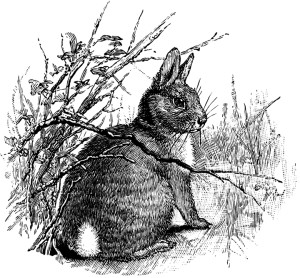by Tina Mitchell
Bugs Bunny is an imposter. Those extraordinarily long ears and gangly limbs expose him as a hare, not a rabbit. Bugs is not the only victim of rabbit confusion. The early settlers on the plains named the first bunny-like beings they encountered “jackrabbits” – but those critters also were hares, not rabbits. Likewise the adorable, alpine-dwelling pika snagged the name “rock rabbit” – again, not a rabbit.
Rabbits, hares and pikas make up the order Lagomorpha. The most widespread and numerous of Colorado’s lagomorphs, our three species of rabbit (aka. cottontails, to differentiate them from European rabbits) look so much alike that it’s easiest to identify them by habitat. Cottontails in a riparian area, such as the Arkansas River drainage, or grazing a lush bluegrass lawn near shrubs in towns east of the Rockies, most likely are eastern cottontails – the shortest-eared of the cottontails. Desert cottontails live in arid habitats, most commonly in the grasslands of eastern Colorado and the semiarid shrublands and piñon-juniper woodlands elsewhere in the state. Mountain cottontails inhabit rocky outcroppings, upland sagebrush and high-altitude open habitats.
Cottontails typically produce 3-5 litters of 3-8 young per year, from March until early fall. Life moves quickly if you’re a young cottontail. At 3-4 weeks old, when you’re only the size of a tennis ball, you’re already independent, living on your own. With eyes positioned on the sides of your head, you can see what’s behind you without moving a muscle. And you’d better keep those eyes focused because you’re on the menu for owls, coyotes, foxes, weasels, snakes, eagles and hawks – just to name a few. Basically, you have about a 15 percent chance of surviving your first year. Good luck to you.
Three species of hare call Colorado home. Black-tailed jackrabbits are the smaller of our two jackrabbit species, with a black-tipped tail and ears and a black stripe running down the lower back. White-tailed jackrabbits have eponymous white-tipped tails and tend to be larger and heavier than their black-tailed cousins. White-tailed jackrabbits once ruled the grasslands around the Arkansas River, but recent cultivation and grazing have encouraged an influx of black-tailed jackrabbits. The more compact snowshoe hare’s most distinctive feature is its varying coat – white in winter, for camouflage in snowy areas; brown in summer. This change happens over 8-10 weeks. On Marshall Pass Road, heading toward the Continental Divide one late June, we actually spotted one mid-transition – sporting its winter-white coat on its belly and feet and its summer-brown coat on its head and back.
[InContentAdTwo]
Hares – especially jackrabbits – can be distinguished from rabbits by their large size and extremely long ears, which reminded the first settlers of their jackasses (hence “jackrabbits”). Their oversized feet and long legs differentiate them from cottontails. In fact, if your first thought when looking at a rabbit-like animal in the wild isn’t “Wow – look at those ears and feet!” you’re probably not looking at a jackrabbit. Differences between rabbits and hares begin early. After a gestation period of about 30 days, baby rabbits (“kittens”) are born completely helpless, naked, and blind. Baby hares (“leverets”) enter the world after 42 days fully furred, able to see and hopping on their own a few hours after birth.
Because of superficial similarities, some people think that lagomorphs are rodents, like squirrels and rats. In fact, lagomorphs are closer to rodents than to any other group of mammals. Both rodents and lagomorphs have incisors that grow continuously throughout their lives, thus requiring constant chewing on tough material to prevent the teeth from becoming too long. But rodents have a single pair of ever-growing incisors. Lagomorphs actually have two pair of upper incisors – one large pair at the front and one small, peg-like pair tucked behind – for clipping off the woody plant material they live on.
Despite their obvious differences, our culture has a long track record of confusing hares and rabbits. The Easter Bunny? According to early legends, a European hare. The Energizer Bunny? A hare. (Even the company’s website calls him that.) The framed Roger Rabbit? A hare. Ricochet Rabbit? Bing, bing, BING! – a hare. Harvey, the six-foot-tall pooka of stage and screen? An invisible hare. So the next time you hear Elmer Fudd cuss out that “wascally wabbit,” you’ll know his archenemy Bugs is really a wascally hare.
Tina Mitchell watches nature with her human and canine family from their perch in the piñon/juniper habitat of western Fremont County. When she needs to pay the bills, she shows up as a research psychologist on the University of Colorado Anschutz Medical Campus in Aurora.



